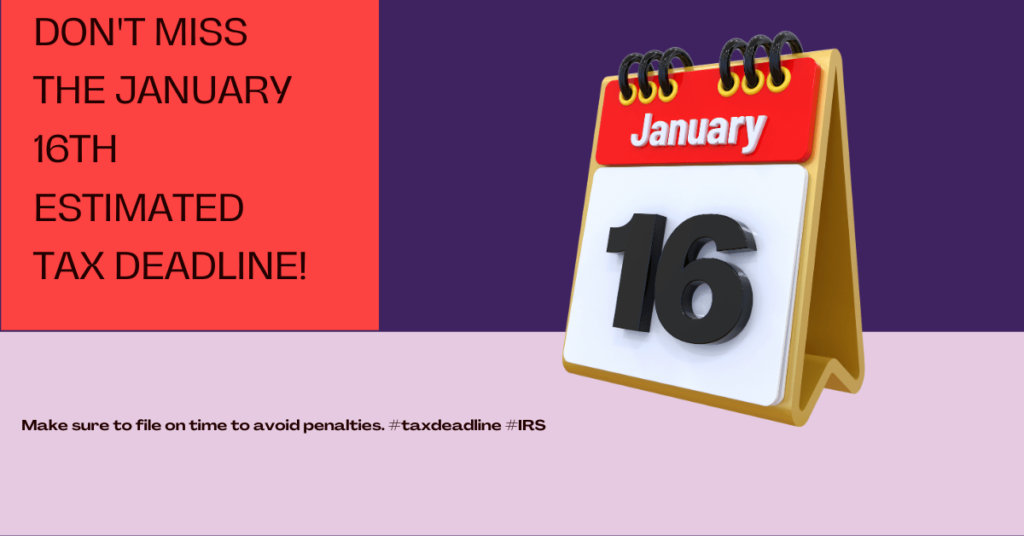Hey Tax Warriors, buckle up! While April 15th may still feel like a distant mountain, there’s a crucial pit stop, Estimated Tax, you don’t want to miss: January 16th, 2024. This date marks the deadline for the final estimated tax payment of the 2023 tax year, and for some folks, it’s a make-or-break moment to avoid those pesky IRS penalties.

So, who needs to be extra attentive to this mid-winter tax checkpoint? Primarily, it’s self-employed heroes, freelance fanatics, and side hustle superstars – basically, anyone who doesn’t have the luxury of automatic paycheck tax withholding. Remember, unlike your salaried counterparts, the responsibility of sending quarterly tax payments to the IRS falls squarely on your shoulders.
Think of January 16th as the closing bell for the fourth quarter of your tax game. It’s your chance to slam dunk that final payment and avoid any unwanted late fees or surprises come April. But why wait until the buzzer sounds? Pro tip: consider making your payment even earlier to give yourself some peace of mind and avoid any last-minute scrambles.
Now, let’s address the elephant in the room: why might someone owe estimated taxes in the first place? Well, there are a few common culprits:
- Underestimating Withholding: Maybe you underestimated your income for the year, or a recent raise threw your calculations off-kilter. This can lead to a gap between what you owe and what’s been automatically withheld.
- Non-Wage Income: Remember, the IRS loves a diverse portfolio, and that includes income from sources like dividends, rental properties, or your booming Etsy shop. If these non-wage earnings aren’t already subject to withholding, you’ll need to factor them into your estimated tax payments.
- Complex Situations: Life throws curveballs, and sometimes your tax situation gets tangled up in knots. Maybe you sold some investments, inherited some moolah, or navigated a life change that impacted your income. These complexities can also necessitate estimated tax payments.
But fear not, tax warriors! The IRS isn’t here to play hide-and-seek with your hard-earned cash. Their website is packed with resources to help you estimate your taxes accurately and make those timely payments. So, whether you’re a seasoned tax pro or a newbie navigating the financial jungle, there’s no shame in seeking guidance.
Who Needs to Pay Estimated Taxes?
This battle cry applies to:
- U.S. citizens and resident aliens: You’re on the front lines if you call Uncle Sam your fiscal commander-in-chief.
- Puerto Rico, U.S. Virgin Islands, Guam, etc. : Even if you’re stationed in these tropical tax territories, estimated taxes might be your duty.
- Nonresident aliens (Form 1040-ES (NR)): International tax warriors, this form is your passport to estimated tax payments.
Make those quarterly payments! Penalties kick in if you:
- Owe more than $1,000 after subtracting withholdings and credits.
- Paid less than 90% of the current year’s tax through estimated taxes.
Exceptions to Estimated Taxes:
Breathe easy if:
- Your net earnings for the quarter were $400 or less (you still need to file a return!).
- You had zero federal income tax last year and didn’t file a return.
- Your income fluctuates and you qualify for the annualized income installment method.
Special Rules:
Not all tax warriors are created equal, so here are some special ops for specific troops:
- Farmers and fishermen: If two-thirds of your income comes from these pursuits, you can substitute 66 2/3% for 90% in the General Rule (2a).
- Household employers: Include your household employment taxes when estimating your 2023 tax if you meet certain criteria.
- Higher income taxpayers: If your 2022 adjusted gross income (AGI) was over $150,000, substitute 110% for 100% in the General Rule (2b).
Remember, staying ahead of the tax game is all about awareness, preparation, and action. Mark January 16th on your calendar (in big, red letters!), gather your documentation and head over to the IRS website to make that final estimated tax payment. By taking control of your tax destiny, you can avoid unwelcome penalties and sleep soundly knowing you’re one step closer to a smooth-sailing April filing season.
So, let’s raise a toast (non-alcoholic, of course, until after April 15th!) to conquering the January 16th deadline and keeping the IRS at bay! Now go forth and slay those estimated tax payments, champions!
Increase Your Withholding:
If you also receive salaries and wages, you can potentially avoid estimated tax payments by amping up your employer’s withholding via Form W-4. Consider this a pre-emptive strike!
Payment Due Dates:
- April 18, 2023: All-in blitz! Pay everything upfront.
- June 15, 2023: Second wave attack! Make your second payment.
- September 15, 2023: Third wave incoming! Don’t get swamped by taxes.
- January 16, 2024: Final assault! Secure victory with your fourth payment.
No January Payment?
There’s a loophole! If you file your 2023 return by January 31, 2024, and pay the entire balance due, you can skip the January 16
